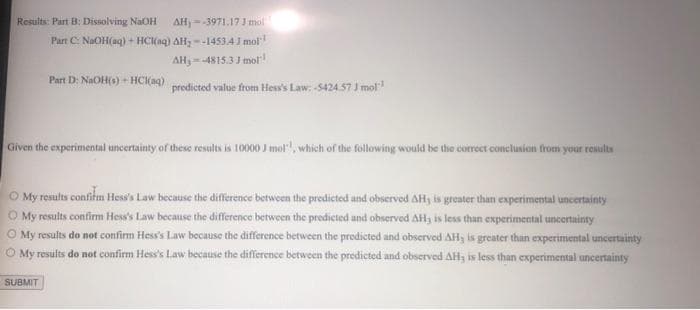Results: Part B: Dissolving NaOH AH) --3971.17I mol Part C NaOH(aq) + HCI(aq) AH, --14534 J mol AH,4815.3 J mot Part D: NAOH() + HCI(ag) predicted value from Hess's Law: 5424 57 I mol Given the experimental uncertainty of these results is 10000 J mol", which of the following would be the correcet conclusion from your results O My results confifm Hess's Law because the difference between the predicted and observed AHy is greater than experimental uncertainty O My results confirm Hess's Law because the difference between the predicted and observed AlHy is less than experimental uncertainty O My results do not confirm Hess's Law because the difference between the predicted and observed AH, is greater than experimental uncertainty O My results do not confirm Hess's Law because the difference between the predicted and observed AHy is less than experimental uncertainty
Results: Part B: Dissolving NaOH AH) --3971.17I mol Part C NaOH(aq) + HCI(aq) AH, --14534 J mol AH,4815.3 J mot Part D: NAOH() + HCI(ag) predicted value from Hess's Law: 5424 57 I mol Given the experimental uncertainty of these results is 10000 J mol", which of the following would be the correcet conclusion from your results O My results confifm Hess's Law because the difference between the predicted and observed AHy is greater than experimental uncertainty O My results confirm Hess's Law because the difference between the predicted and observed AlHy is less than experimental uncertainty O My results do not confirm Hess's Law because the difference between the predicted and observed AH, is greater than experimental uncertainty O My results do not confirm Hess's Law because the difference between the predicted and observed AHy is less than experimental uncertainty
Chapter28: Atomic Spectroscopy
Section: Chapter Questions
Problem 28.13QAP
Related questions
Question

Transcribed Image Text:Results: Part B: Dissolving NaOH
AH)--3971.17 J mol
Part C NaOH(aq) + HCI(aq) AH; --1453.4J mol
AH-4815.3 J mol
Part D: NaOH() + HC(aq) prodicted value from Hew's Law: -5424 57 J mol"
Given the experimental uncertainty of these results is 10000 J mol", which of the following would be the correet conclusion from your results
O My results confifm Hess's Law because the difference betwoen the predicted and observed AHy is greater than experimental uncertainty
O My results confirm Hess's Law because the difference between the predicted and observed AH3 is less than experimental uncertainty
O My results do not confirm Hess's Law because the difference between the predicted and observed AH, is greater than experimental uncertainty
O My results do not confirm Hess's Law because the difference between the predicted and observed AH; is less than experimental unecertainty
SUBMIT
Expert Solution
This question has been solved!
Explore an expertly crafted, step-by-step solution for a thorough understanding of key concepts.
Step by step
Solved in 2 steps

Recommended textbooks for you



